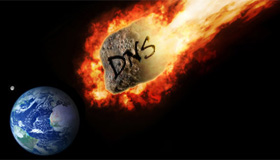Headline: Rampant DNS Outages, Multitudes of Websites down, Millions of Users Impacted

(well, you get the point…)
DNS Outages – The Aug. 15, 2012, AT&T DNS outage and Sept 10, 2012 GoDaddy DNS outage, did in fact, take down vast numbers of websites and impacted millions of Internet users. Moreover, a piece of malware called the DNSChanger aka the “Dooms Day Virus” was suppose to take down even bigger chunks of the web in July 2012 (it didn’t). Underlying the otherwise friendly world of web browsing the Domain Name Server (DNS) system, for most users of the web, is a mysterious “beast of such power that if you were to see it whole and complete in a single glance, it would burn you to cinders” (thank you Merlin for that quote from the 1981 movie “Excalibur”). Moreover, as 2012 proved large DNS outages did impact vast areas of the Internet when they hit. However, the DNS process doesn’t need to be a mystery and there are steps you can take to learn more and to protect yourself and your website from DNS outages.
Free DNS Testing
There is a certain statistical inevitability to DNS issues. Why? Because the DNS process, like the mysterious beast of the Excalibur movie, is everywhere. The DNS process is ubiquitous – every network runs on it – and there are trillions of DNS requests running every day. The DNS systems is, however, not that frightening. In fact, you can see how it works on any website in the world free right here (select Trace Style “DNS”). The free tool should show that by typing in a URL www.mywebsiteexample.com, the browser runs the URL through the DNS process, finds the Internet Protocol (IP) numbered address ex. 192.168.0.0 and the browser connects to the server 192.168.0.0 to fetch the page mywebsiteexample.com.
Free Trial: Worldwide DNS Monitoring
Website monitoring that uses a “non-cache based” monitoring methodology accurately detects DNS issues. However, a cache-based monitoring service will not accurately detect DNS issues. On the one hand, a DNS monitoring solution using a non-cache method propagates DNS queries all the way through to root name servers with each monitoring instance. Set up a free trial of DNS monitoring here. On the other hand, a cache-method service caches DNS and therefore will not detect a secondary DNS issue at all, or it may take days or weeks to detect the issue.
Free Webinar: Building a DNS “Dome”
Register now and start building your DNS bomb-shelter to prevent website downtime! Join us, Wed, Mar 27, 2013 from 2:00 PM – 3:00 PM EDT. Register here: Dyn Webinar: Intro To Managed DNS Load Balancing featuring Dotcom-Monitor

